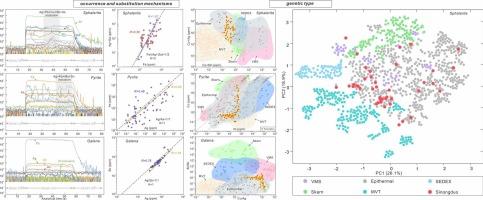LA-ICP-MS analysis of sulfides from the Sinongduo Ag-Pb-Zn deposit, Tibet: Insights into element incorporation mechanisms and ore genesis
IF 3.6
2区 地球科学
Q1 GEOLOGY
引用次数: 0
Abstract
As one of the most significant Ag-Pb-Zn deposits in the northern Gangdese polymetallic belt, the Sinongduo has been widely concerned since its discovery and hosts proven reserves of 148,136 t Pb (1.95 %), 205,722 t Zn (2.70 %), and 400 t Ag (52.33 g/t). Despite its economic importance, the mechanisms of Ag incorporation in sulfides and deposit genetic type remain debated. This study mainly employs in situ LA-ICP-MS trace element analysis of sulfides (sphalerite, pyrite, and galena) to address the above issues. Three mineralization stages are identified: (Ⅰ) pre-ore pyrite + quartz stage, (Ⅱ) sphalerite + galena + pyrite + minor chalcopyrite + Ag-bearing minerals main stage, and (Ⅲ) post-ore calcite + quartz stage. LA-ICP-MS depth profiles and multivariate statistical analysis reveal trace elements are primarily hosted as lattice-bound solid solutions and nanoscale inclusions, with limited micro-inclusion formation. In the Sinongduo deposit, where silver is the most critical element, its substitution mechanisms exhibit significant differences among sphalerite, pyrite, and galena. In sphalerite, silver incorporates into the crystal lattice via coupled substitutions involving the replacement of Zn by Fe, Cu, Sb, Ga, and Sn. In pyrite, silver enters the lattice through coupled substitutions where Fe is replaced by As, Sb, and Co. In galena, silver is incorporated into the lattice through coupled substitutions where Pb is replaced by Sb and As. Trace element thermometry (GGIMFis geothermometer) yields ore-stage temperatures of 226.0–288.0 °C (mean = 256.8 °C), consistent with fluid inclusion data. The trace element distributions in the Sinongduo sulfides, such as Fe, Mn, Cu, Ag, Sn, and Pb enrichment and Ga, Ge, In, and Co depletion in sphalerite, together with the supports from the host rock, alteration, texture and mineral assemblages, suggest that the Sinongduo deposit is a typical epithermal deposit. This study establishes the Sinongduo deposit as a typical epithermal system and demonstrates that in situ LA-ICP-MS analysis of sulfide trace elements provides robust constraints on deposit genesis.

锡农多是冈底斯多金属带北部最重要的银铅锌矿床之一,发现以来受到广泛关注,探明Pb储量为148136 t (1.95%), Zn为205722 t (2.70%), Ag为400 t (52.33 g/t)。尽管银在硫化物中的结合机制和矿床成因类型具有重要的经济意义,但仍存在争议。针对上述问题,本研究主要采用原位LA-ICP-MS对硫化物(闪锌矿、黄铁矿、方铅矿)进行微量元素分析。成矿阶段分为(Ⅰ)矿前黄铁矿+石英阶段、(Ⅱ)闪锌矿+方铅矿+黄铁矿+少量黄铜矿+含银矿物主阶段和(Ⅲ)矿后方解石+石英阶段。LA-ICP-MS深度剖面和多元统计分析表明,微量元素主要以晶格固溶体和纳米级包裹体的形式存在,微包裹体的形成有限。在以银为最关键元素的锡农多矿床中,闪锌矿、黄铁矿和方铅矿的替代机制存在显著差异。在闪锌矿中,银通过铁、铜、锑、镓和锡的偶联取代而融入晶格。在黄铁矿中,银通过偶联取代进入晶格,其中Fe被As、Sb和Co取代。在方铅矿中,银通过偶联取代进入晶格,其中Pb被Sb和As取代。微量元素测温(GGIMFis地温计)测得矿级温度为226.0-288.0°C(平均为256.8°C),与流体包裹体数据一致。在闪锌矿中Fe、Mn、Cu、Ag、Sn、Pb富集和Ga、Ge、in、Co亏缺等微量元素的分布特征,以及寄主岩、蚀变、结构和矿物组合的支撑作用,表明该矿床为典型的浅成低温热液矿床。本研究确立了锡农多矿床为典型的浅成低温热液系统,并证明了原位LA-ICP-MS分析硫化物微量元素为矿床成因提供了强有力的约束。
本文章由计算机程序翻译,如有差异,请以英文原文为准。
求助全文
约1分钟内获得全文
求助全文
来源期刊

Ore Geology Reviews
地学-地质学
CiteScore
6.50
自引率
27.30%
发文量
546
审稿时长
22.9 weeks
期刊介绍:
Ore Geology Reviews aims to familiarize all earth scientists with recent advances in a number of interconnected disciplines related to the study of, and search for, ore deposits. The reviews range from brief to longer contributions, but the journal preferentially publishes manuscripts that fill the niche between the commonly shorter journal articles and the comprehensive book coverages, and thus has a special appeal to many authors and readers.
 求助内容:
求助内容: 应助结果提醒方式:
应助结果提醒方式:


